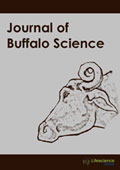jbs
|
|
Abstract: The buffalo calf is more challenging to adapt to the transition from breast milk to other substitutes that favor weaning. Keywords: Buffalo calf, calf breeding, weaning, milk replacer. |
|
|
Abstract: The river buffalo is an emerging production species worldwide; indeed, it is overtaking other cattle as a producer of meat and milk in some countries. Though both species belong to the Bovidae family, they show significant anatomical, physiological, and behavioral differences due to their different phylogenetic positions. The river buffalo is a rustic animal that can benefit from low-quality, fibrous forages due to its digestive system, in contrast to beef cattle or dairy cows. Besides, the buffalo cow’s reproductive apparatus has fewer cervical muscle rings and a shorter vagina and cervix. This species has maintained its seasonal breeding pattern, also in contrast to Bos indicus and Bos taurus. Even though buffaloes have an inefficient thermoregulating system, scarce hair, and a thicker epidermis, they are more resistant to tropical weather conditions if water for wallowing is available than dairy cows, which in turn adapt better to temperate zones. Due to the morphology of the river buffalo’s mammary glands, they produce less milk, while their conical teats with narrower sphincters decrease predisposition to mastitis compared to dairy cows. Thus, the study of the anatomical and physiological differences among river buffalo, Bos Taurus, and Bos Indicus will allow the implementation of strategies to improve the former’s productivity while also increasing welfare levels according to the production system in which they are raised. Keywords: Behavior, buffalo production, buffalo disease, cattle, river buffalo, dairy. |
|
|
Abstract: Between 1961 and 2018 on the total number of dairy ruminants, the percentage of buffaloes and the quantity of milk produced by them had an increasing trend from 3.7% to 5.2% and from 5.4 to 15.7%, respectively; this value on the world total "cow milk + buffalo milk" rose to 18.64%. Keywords: Buffalo milk, world buffalo milk, italian buffalo milk. |
|
|
Abstract: This review's objective is to provide information on the mechanisms that buffaloes express during the thermoregulation process. Generally, the water buffalo is associated with warm and tropical climates. In these systems, the combination of high temperature, relative humidity, and radiation cause different physiological and behavioral changes, particularly during the summer months. Wallowing behavior in water or mud promotes heat dissipation through physical mechanisms, such as conduction, convection, and radiation. Furthermore, the provision of natural or artificial shades contributes to thermoregulation and maintains homeostasis. In production systems in cold climates, the wallowing behavior is inhibited by the water temperature, so it is important to keep the animals protected in stables to avoid the cold winds and rapid drops in temperature, causing increased illness pneumonia and sometimes death. Finally, in cold conditions, the animals require an appropriate diet since the use of energy is distributed mainly for the production of heat. Thus, heat stress and cold stress generates relevant problems in health, welfare, and productivity in water buffaloes. A comprehensive assessment of the severity of the resulting problems associated with thermal stress and specialty in cold stress in water buffaloes is necessary so far, and there's very little information about it in this species. Keywords: Cold stress, thermal stress, microclimate, behavior, welfare. |
|
|
Abstract: This article aims to review both the economic impact of reproductive failures on the profitability of water buffalo systems and the effect of different factors on the reproductive performance of water buffaloes. Besides, an overview of various non-hormonal alternatives to improve reproductive performance is made. The optimal reproductive efficiency in water buffaloes implies calving to conception interval around 90 days to reach a calving interval of 400 days, with longer calving intervals having a negative impact on profitability. Reproductive efficiency is the consequence of the interaction of genetic and non-genetic factors, and the recognition of these factors by analyzing the reproductive information must be a priority. Although each factor's impact can be of greater or lesser magnitude depending on the conditions of each herd, some factors like nutrition, milk yield, body condition score, negative energy balance, parity, bull presence, low estrus intensity, and season can be considered high-impact factors. Not all factors are common among farms; therefore each farm must implement a program for the identification, control, and prevention of reproductive problems, especially during early lactation, to prevent a long anestrus; and when artificial insemination is used, so that it is done at the correct time with respect to the beginning of estrus to enhance fertility. Keywords: Parity, season, BCS, energy balance, milk yield, silent estrus, anestrus. |


